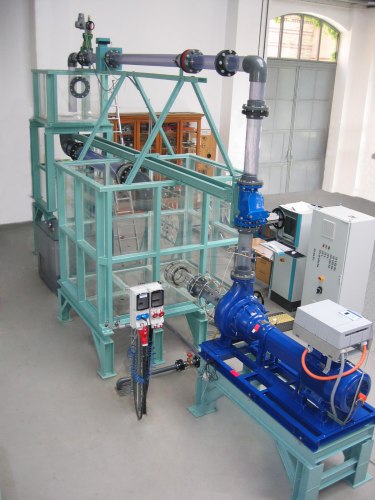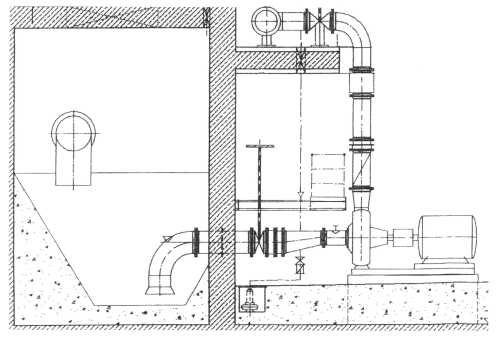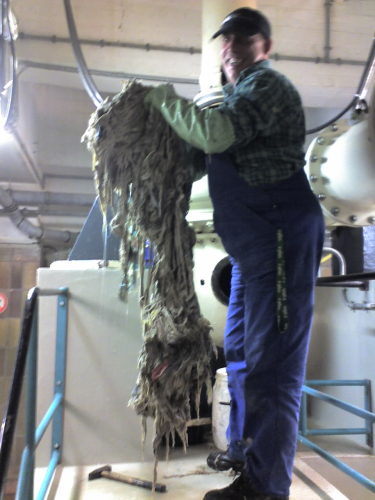


Sewage pumping stations serving medium-sized to large cities often comprise one or more electrically driven dry pumps, with power and control supplied via frequency converters and computerised control systems. Often, such plant is equipped with a pump diagnosis system. Because of the higher degree of automation used today, as well as changes in the nature of the sewage itself, operational problems occur because of sewage pump clogging.
Methodology
A new approach for the investigation of sewage pumping system clogging has been carried out by including all relevant elements in the experimental arrangement. The strong interaction between control system, fluid flow and operational behaviour results in effects that are only detectable using an overall system approach.
TU Berlin Fluidsystemdynamics, Berliner Wasserbetriebe and KSB, therefore, built up a complete sewage pumping station in scale 1:3 (Figure 1). All major parts, such as suction basin, pipes and elbows, are made of synthetic glass, which allows detailed investigation and documentation of clogging phenomena in different areas.
The result has been a new understanding of the reasons why different kinds of clogging occur in a sewage pumping system. Typical clogging scenarios have been simulated and clustered, always compared with practical experience in the field. This new understanding has led to operational improvements in sewage pumping.
Background
Pumping systems are becoming ever more complex, in part through the introduction of modern computer based control networks. Therefore, human observation and subsequent corrective action is often not possible today at the ‘front end’. In addition, much historical experience and special knowledge held by long-serving sewage plant personal is not incorporated into the control software for the respective expert systems. It is recognised that it is very important to reduce the level of information for correct pumping station operation to a minimum, with a 'hidden' collection of data for maintenance and optimisation. Yet control networks have mainly focused upon plant operation, while other, potentially useful, information has not been integrated until now.
Until recently, sewage plant investigation has mainly focused on the separate components of fluid systems, especially the sewage pump itself, which has been improved significantly over the past few decades. Both impeller and casing designs have been adapted to better suit the special requirements of sewage pumping applications. The most recent example of this trend has been the successful adoption into the market of semi open screw impellers.
However, there are still many problems within the sewage pumping sector, mainly because of pump clogging, made worse by the lowering of water content in sewage through the more economical use of water by domestic machines, and others. At the same time, however, the operation regime became more flexible, following increasing application of variable frequency drives (VSDs) and automation techniques. These allow clear and very significant energy savings to be achieved through optimisation of network parameters.
A new, complete system approach
The new approach involves the complete system. All components are connected via the control system and interact with each other. Research and development only will be successful if all interactions are taken into account. Optimisation is possible, especially with the process. How to realise such a system approach in practise is the crucial point.
The sewage pumping stations - Berliner Wasserbetriebe serves about four million people and manages a sewage flow of approximately 630,000 m³/day. This large volume is pumped using 143 pumping stations of various sizes. Small pump shafts for, in some cases, just a couple of households equipped with submersible sewage pumps are often used, but so also are large pumping stations equipped with sewage pumps in dry installation. Depending on the sewage quality, pumps are equipped with varying designs of impeller. Typical of larger pumping stations is the layout shown in Figure 2. It consists of channel pipe, suction sump, suction elbow, sewage pump, discharge pipe, non-return valve and control valve.
Berliner Wasserbetriebe introduced a new design of control system network to manage all sewage pumping station based on one leading control base. The essential concept leads to optimisation of sewage volume control between pumping stations and purification plant. Operation of such sewage pumping stations includes control of the suction basin level, the valves, and the newly introduced VSDs that look after pump speeds. Typical influences on sewage flow include daily and special events, as well as climate change. These are now manageable and lead to reduced energy consumption and better purification efficiency.
Parallel to the introduction of the new control system network, higher rates of clogging were observed, especially where pumps were speed controlled (using VSDs). Berliner Wasserbetriebe contacted its pump supplier, and the Chair of Fluidsystemdynamik at Technical University Berlin to investigate the problem. As all plant components were likely to be affected, it soon became clear that the complete system had to be taken into account in the investigations. Hence the complete system approach adopted.
The situation analysis
This involved seven representative sewage pumping stations, equating to around 150 cases of trouble annually. Investigation showed that in most cases, the following clogging scenario occurs: long fibrous sewage content builds up to the large ‘pigtail’ shape often found on the suction side of sewage pumps. This sewage ‘pigtail’ sometimes reaches over 20 litres volume, or 1.5 m in length. The sewage pump will surely be clogged, resulting in reduced flow, and often, increased power consumption too. A typical sewage ‘pigtail’ is shown in Figure 3.
The formation of sewage pigtails occurs for several reasons:
- Swirls inside the suction sump may form such a pigtail. The sewage pigtail may be already formed inside the sewage channel in dry weather conditions; the upcoming sewage will roll the long fibrous contents.
- A clogged sewage pump will be stopped by the control network, which will then start the redundancy pump. A technician has to go to the clogged pump, open it and remove the clogging, etc. The costs and downtime involved can be remarkably high.
The experimental set-up
How to investigate effects in a sewage system? The new approach results in a build-up of the complete system from sewage channel to discharge to the purification plant.
The test loop reproduces a complete one third size sewage pumping station model, as already described. In addition, a fully equipped control system, including a diagnosis tool, is used to simulate the complex system control network.
Flow rates up to 300 m³/h, and a power consumption up to 40 kW can be achieved with this test loop. All relevant sewage pump types, plus the typical hardware components of a complete system can be installed. Because sewage is rightly known as 'black water', nobody has ever directly seen the built-up of such sewage pigtails. Therefore, the fact that all major components were made from synthetic glass to allow direct observation of clogging phenomena was an essential feature.
The test programme
Experimental investigation of sewage pump clogging phenomena needs to be as close as possible to the real behaviour of sewage. First, several materials that can cause clogging are evaluated in the test loop, which shows the same clogging scenario compared with real cases in actual sewage pumping stations. A good compromise was found in the use of a modern synthetic duster having a high tensile strength. An additional advantage of this is the relatively long lifetime during the experiments – such materials will pass the pump several times without damage.
Next, the phenomenon of clogging was structured into seven typical scenarios, which display typical clogging inside a sewage system. Once again, it is essential to remember that the complete sewage pumping system is being observed. For this reason, phenomena found in both suction pipe and suction sump are included.
Systematic tests covering the main plant operation points also needed variation of operational flow and speed to be factored in. The researcher took part load as being 40% BEP (Best Efficiency Point), to overload conditions at 120% BEP, together with running speeds from 700 rpm to the design speed of 1,450 rpm. A two-vane impeller was used for the first test.
The results
Measurement of phenomena is often not easy as no clear data or values may be present. On the other hand, structural and methodical understanding needs logical structure. Therefore, the experimenters used a clustering technique in order to understand the main influences.
A strong operational influence on the position and extent of clogging was clear. From the results, initial guidelines became obvious:
- Major clogging of the suction sump occurs at heavy part load and low speed.
- The danger of impeller gap clogging occurs at slight part load and medium speed.
- There is no danger of impeller channel clogging at higher flows and speeds.
This information provides a good understanding about clogging related to operational behaviour – for example, part load and low speed together must be avoided. Improvements can be made through the careful selection of operation points (speed. load etc), care with velocities, and careful design of all relevant pipes and chambers.
Looking at the measured data, significant signal variation correlates with clogging phenomena. This is especially so with the signal variation deriving from the suction pressure transducer, which provides significant information - with dusters going into the impeller, an increase of signal amplitudes in higher frequency ranges were detected. Furthermore, pressure differences change with dusters entering in the casing. Here, the potential for a clogging diagnosis is obvious.
In addition, the researchers have been able to add a new explanation for the formation of sewage pigtails. First, the impeller becomes clogged by a volume of dusters. Then the pump stops and re-circulation develops, combined with a degree of backflow into the suction pipe. The fluid flow pushes back the dusters and forms the pigtail.
The outlook
The next steps to take in this research program will be to extend it to take in more pump types, and to further examine the clustering of data measurements.
Generally, a relation between phenomena and signal variation could be demonstrated.
Based upon this, a diagnosis system will be developed specifically for sewage pumping systems.
In addition to diagnosis, an active resulting programme will be initiated with the aim of avoiding or removing clogging altogether. This is, it is thought, possible to achieve using existing sewage pumping system components, using a control system to start automatic speed change programs, close valves, or add start/stop procedures in suitable ways. At the same time, new products and systems, such as back flush arrangements, spray nozzles, etc. will also be developed.
Acknowledgements
Chair of Fluidsystemdynamik like to thank the project partner Company AUCOTEAM, Berlin, as well as other involved companies, Berliner Wasserbetriebe and KSB. Financial support was provided by ‘Programm zur Förderung von Forschung, Innovationen und Technologien - ProFIT ‘, Berlin - part of European Program EFRE.
This paper was first presented at the Pump Users International Forum 2008, held in Düsseldorf, Germany in October 2008, and is reproduced with permission of the VDMA eV.
For references, please contact the editor.





